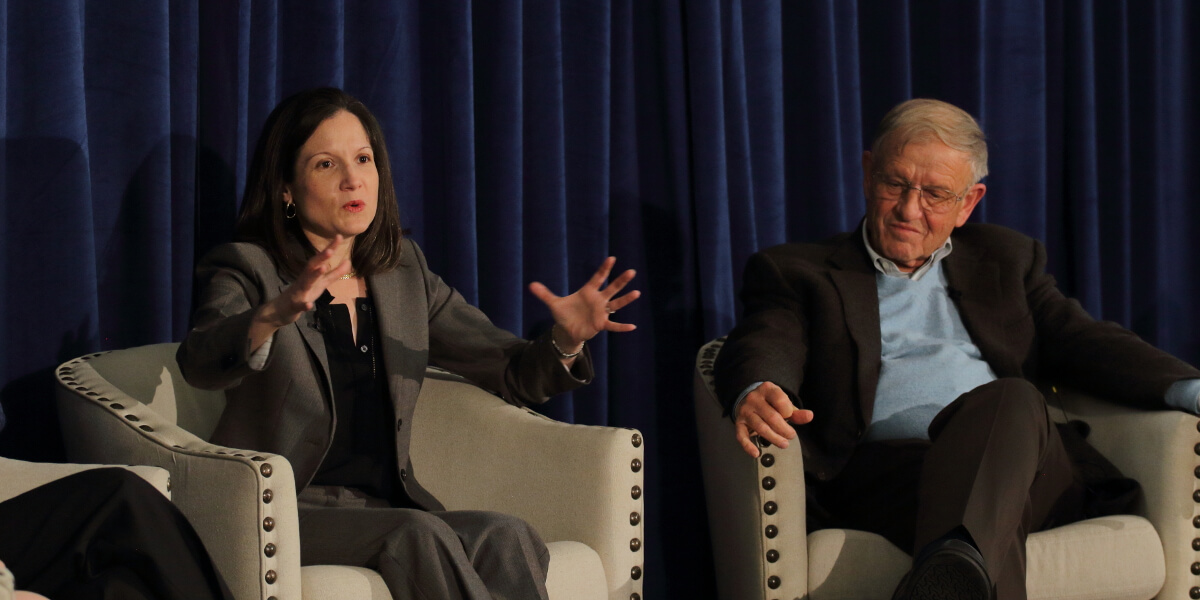
From L-R: Dr. Leroy Hood, Professor Andrea Armani, Vice Dean for Technology Innovation and Entrepreneurship Andrea Belz, and Dr. Marvin Caruthers Photo courtesy of the National Science and Technology Medals Foundation
On March 21, the National Science and Technology Medals Foundation (NSTMF) presented “An Evening with Biotech’s Best” at the USC Michelson Center for Convergent Bioscience. Among the panelists were two NSTMF laureates, Dr. Marvin Caruthers and Dr. Leroy “Lee” Hood, and Professor Andrea Armani, Irani Chair of Chemical Engineering and Materials Science.
Andrea Belz, Vice Dean for Technology Innovation and Entrepreneurship, led the panel through each member’s path in scientific innovation, delving into their past experiences and perspectives on the future.
Hood and Caruthers have several combined scientific and technological breakthroughs that led to the automated DNA synthesizer. Caruthers discovered the chemistry reactions behind DNA synthesis, while Hood developed the instrument that automated the synthesis process. For the impact of their work, each was awarded a National Medal of Science, the nation’s highest honor in science (Hood in Biology; Caruthers in Chemistry). Armani, a faculty member of the Michelson Center, is well-known in the biotechnology field for developing new ways to detect and understand how cancer progresses.

Dr. Andrea Belz and Dr. Leroy “Lee” Hood at “An Evening with Biotech’s Best.” Photo credit/Dylan Cavaz – USC Viterbi
When toys are more than child’s play
Having what Belz described as a “tinkering mindset” since childhood was fundamental to her career choice in STEM. Belz fondly recalled her own circuit kit from Radio Shack that she loved playing with as a child.
As a kid, Armani played with Lincoln Logs®, a toy consisting of notched miniature logs which she used to build tiny cabins and teepees. She said that having a very “hands-on building toy set” from an early age greatly influenced her career as an engineer.
Hood described his childhood experience as more “theoretical.” Growing up in Montana, his father was an electrical engineer at AT&T who also taught local university classes that Hood would attend on occasion.
“Those courses profoundly changed how I thought about biology,” said Hood. “I had an engineering view of life that I superimposed on biology [later on].”
Caruthers performed a chemistry magic show in sixth grade and “read all the science fiction books in the Des Moines Public Library.” He also participated in a high school science club led by a teacher who took them to local hospitals and analytical laboratories, inspiring many of his classmates to pursue careers in science.
Re-inventing the research space (and mindset)
Armani, who leads an interdisciplinary research team, described how the Michelson Center’s open floor plan alters the paradigm of performing research. Instead of individual, walled-off laboratories which isolate researchers, the space is completely open, allowing free movement and communication between groups from different disciplines.
Armani’s team cohabits a floor with a bioinformatics group and a group dedicated to electrical engineering and implantable devices. Added Armani, “You just end up with this giant melting pot of researchers. They have each other to learn from and that’s one of the beauties of USC and this building.”

Professor Andrea Armani and Dr. Marvin Caruthers Photo courtesy of Dylan Cavaz – USC Viterbi
Caruthers furthered that, over the last 15-20 years, universities have changed their approach to scientific research by deliberately making it a communal effort.
“Science is a community effort on most campuses these days,” Caruthers said. “It’s not a departmental story but almost like a university experiment in systems science.”
Making an impact
The panel also discussed the challenges of “high-risk, high-reward” research of the type that earned Caruthers and Hood the National Medal and Science. An imperative in research is to stay the course in challenging circumstances and resolve your way through difficulty. Added Belz, “It’s very hard to develop disruptive technologies without disrupting something, so you need to have a certain element in your character, which is ‘I’m going to figure out how to make this happen.’ ”
“I think one of the most important attributes of a scientist is determined optimism,” Hood said.
Hood brought up an unavoidable hazard of the trade — dealing with criticism in research – and said that believing in yourself is paramount to getting past rough moments. Armani suggested that failure should be framed in a positive light — as a “stepping stone” to getting to the next measure in your research.
“In research, 20 percent of your ideas might work. You have to be fully prepared for those odds.”- Dr. Marvin Caruthers
“In research, 20 percent of your ideas might work,” Caruthers said. “You have to be fully prepared for those odds.”
Sponsored by Amgen, the event was a joint effort between the NSTMF, the USC Viterbi School of Engineering and the USC Dornsife College of Letters, Arts and Sciences. To view the photos from the event, please go to the USC Viterbi Flickr album.
About the Michelson Center for Convergent Bioscience
By drawing from a diverse network of scientists, engineers and students, the USC Michelson Center for Convergent Bioscience fosters biomedical discovery, innovation and real-world solutions to fast-track detection and cures for diseases ranging from microbial infections to Alzheimer’s and cancer.
In fall 2017, USC opened the hub for the initiative, Michelson Hall — a 190,000 square-foot, high-tech research facility supported by a $50 million gift from retired spinal surgeon Gary K. Michelson and his wife, Alya Michelson.
Published on March 30th, 2018
Last updated on April 8th, 2021











